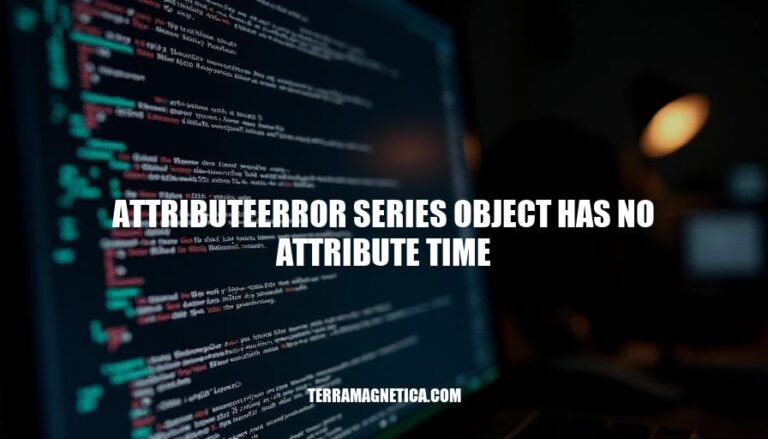


The AttributeError: 'Series' object has no attribute 'time' error in Python occurs when you try to access the time attribute on a Pandas Series object, which doesn’t have this attribute. This error often happens when working with datetime data in Pandas, and you mistakenly try to use a method or attribute that is meant for datetime objects directly on a Series. To fix this, you need to use the .dt accessor to access datetime properties of the Series.
Here are some common scenarios that lead to the AttributeError: 'Series' object has no attribute 'time' error in pandas:
Incorrect Method Usage:
time is not a method available for Series objects.Confusion Between DataFrame and Series:
Typographical Errors:
time instead of the correct method or attribute name.Attribute Not Present:
time is not one of them.Improper Data Handling:
If you encounter this error, double-check the object type and ensure you’re using the correct methods and attributes for Series objects.
To identify and fix the AttributeError: 'Series' object has no attribute 'time' error in your code, follow these steps:
AttributeError: 'Series' object has no attribute 'time'
Check the Attribute:
Series objects in Pandas do not have a time attribute.Use the Correct Accessor:
dt accessor to access datetime properties.import pandas as pd
# Example Series with datetime data
dates = pd.Series(pd.to_datetime(['2021-05-30', '2020-03-23', '2022-02-24']))
# Correct way to access time
times = dates.dt.time
print(times)
Convert to Datetime:
pd.to_datetime() if necessary.dates = pd.to_datetime(dates)
Use apply Method:
apply method with a lambda function.times = dates.apply(lambda x: x.time())
print(times)
By following these steps, you can effectively debug and resolve the AttributeError in your code.
To resolve the AttributeError: 'Series' object has no attribute 'time' error in Pandas, you can use the dt accessor or the apply method. Here are the solutions and workarounds:
dt AccessorIf you are working with datetime objects in a Pandas Series, use the dt accessor to access datetime properties.
Example:
import pandas as pd
# Sample data
dates = pd.Series(['2021-05-30 08:45', '2020-03-23 12:30', '2022-02-24 10:30'])
dates = pd.to_datetime(dates)
# Accessing time using dt accessor
times = dates.dt.time
print(times)
apply MethodYou can also use the apply method with a lambda function to apply datetime methods to each element in the Series.
Example:
import pandas as pd
# Sample data
dates = pd.Series(['2021-05-30 08:45', '2020-03-23 12:30', '2022-02-24 10:30'])
dates = pd.to_datetime(dates)
# Accessing time using apply method
times = dates.apply(lambda x: x.time())
print(times)
dt Accessor: Prefer using the dt accessor for better readability and performance.By following these solutions and best practices, you can effectively resolve the AttributeError: 'Series' object has no attribute 'time' error in your Pandas code.
To prevent the AttributeError: 'Series' object has no attribute 'time' error in future projects, follow these guidelines:
Use pd.to_datetime():
pd.to_datetime(series), not series.to_datetime().import pandas as pd
series = pd.Series(['2023-01-01', '2023-02-01'])
series = pd.to_datetime(series)
Access datetime properties with .dt accessor:
.dt to access datetime properties like year, month, day, etc.series.dt.year
series.dt.month
Avoid direct datetime method calls on Series:
strftime should be used with .dt.series.dt.strftime('%Y-%m-%d')
Ensure proper datetime parsing:
parse_dates in pd.read_csv() or pd.read_json().df = pd.read_csv('data.csv', parse_dates=['date_column'])
By following these practices, you can handle datetime data in pandas effectively and avoid common errors.
: Research Data Pod
: Pandas Documentation
Need more help with pandas? Feel free to ask!
To resolve the ‘AttributeError: Series object has no attribute time’ error, it’s essential to understand that pandas Series objects do not have a built-in ‘time’ attribute.
Instead, you can use the ‘apply’ method with a lambda function to extract the time component from datetime objects. Alternatively, you can convert your Series to datetime using ‘pd.to_datetime()’ and then access the time component using the ‘.dt’ accessor.
Best practices include ensuring that your Series contains datetime objects before applying datetime methods, using the ‘.dt’ accessor for better readability and performance, and implementing error handling to manage cases where the Series might not contain datetime objects.
To prevent this error in future projects, use ‘pd.to_datetime()’ to convert your Series to datetime, access datetime properties with the ‘.dt’ accessor, avoid direct datetime method calls on Series, and ensure proper datetime parsing when reading data. By following these practices, you can handle datetime data in pandas effectively and avoid common errors.